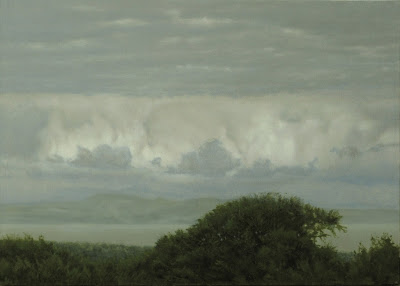oil on canvas 90x70cm
This was actually started way back in April 2014, and was worked on in four or five blocks of time over the last two years.
There is some sound to go with it, but because of the extended production period I’ve listened to all sorts of music and radio during that time, and there’s nothing that I can really call a constant. When I’m working I’m sometimes listening to drama or speech stuff, and sometimes I need to be energised with a bit of rock or pop - mostly oldies – though that doesn’t always result in better painting. Usually, I’m looking for something that will tick over and produce an introvert mood, but stimulating enough that I can find resonances between what I’m hearing and what I’m trying to produce. Two pieces that did that during this painting’s final approach recently were the aptly titled ‘Falling Shadow’, and the more haunting ‘Path 5 (delta)’ – both by Max Richter
The finished composition is a combination of two very different sources. The landscape setting is an anonymous roadside in Russia, from google streetview. It’s nothing special, just some country about 80 miles northwest of Moscow, but I liked the light, and the arrangement of the trees and bushes. The figure is from a US army film* documenting the WWII ceasefire in Czechoslovakia. The cameraman was filming the German soldiers coming over to the Americans, but he happened across a group who had been set upon by Czech partisans. Some had been beaten – and are clearly terrified - but others were killed, one of whom is a beautiful young boy.
The catalyst that linked these two images is Brueghel’s ‘Landscape with The Fall of Icarus’, at which I was having a good look at the time. In that painting, if you look closely behind the tree on the left you’ll see that Breughel has placed what could be a body under the hedge. Copying Mr Breughel, I simply took the German boy and placed him under my found bushes. I swapped my source sky and background for a more open view from along the road, then flipped it all left to right so that the figure was in the lower right-hand corner.
The shadows cast onto the ground and bushes are from trees directly behind the viewer, and I liked the dappled foreground against the full-lit distance - and the dappled lighting helped make the boy less obvious. I had a lot of trouble trying to work out the structure of the trees and bushes from the source, but I think I’ve got away with it. But it’s all about the light bouncing around anyway, and I was careful not to go too dark, and kept the whole scene bright.
I’m weaning myself off Lead White (sigh), but as I had started with it, I kept on the palette throughout. Which was very pleasant. It was very necessary too; for some reason the surface developed a long surface ridge right in the middle of the sky. It was an area I wanted to keep absolutely free of cloud – which could have helped disguise the anomaly – so I had what I euphemistically called ‘a problem’. I filled both sides of the ridge with stiff tinted Lead White, and left it to dry thoroughly – for several months. I rubbed that down, then did it again. Finally, the surface was smooth enough to proceed, so I finely matched in the colour then overpainted the repair together with the rest of the sky. I used the Lead White because I knew that it would dry right through very evenly, and that it was the same substance as the rest of the painting. I could have used a rapid-drying epoxy filler, but I feared that after a few years of the canvas expanding and contracting it would simply detach and fall off. Time will tell of course, but under normal conditions, now, you really can’t see that there’s been a repair. Which is a Good Thing, and would have been more tricky with slower-drying and weaker Titanium White. So there.
As usual I’ve used layers of fairly thin paint (no specific reason; I just prefer thin paint) but was getting in a state about the warmer pales over darks going cool in colour. I finally gave up laying thin cadmium oranges over the shadows in order to get dull brown, and simply drew with ‘generic’ pales – yellow ochre or something like – then glazed over with Burnt Sienna or Umber. A little trick which really has proved very useful since.
There is, of course, yet another layer of resonance for me within the painting. My grandmother – Nana – had a framed print above the piano in her front room in Streatham, in London. It was of a young boy lying on his back in the sun, and I was fascinated by it. That print will have long disappeared by now, but I discovered five decades later that it was of Franz von Lenbach’s ‘A Shepherd Boy’. It may be that part of the reason that I was so struck by the boy in the film was that he is so similar to that long-remembered figure, even down to his red jersey.
Though, one has his whole life ahead of him - and the other has not.
US army film* The figure appears at 6.16mins. Please bear in mind before viewing that this is raw, uncensored footage. The boy appears at 6.16mins











